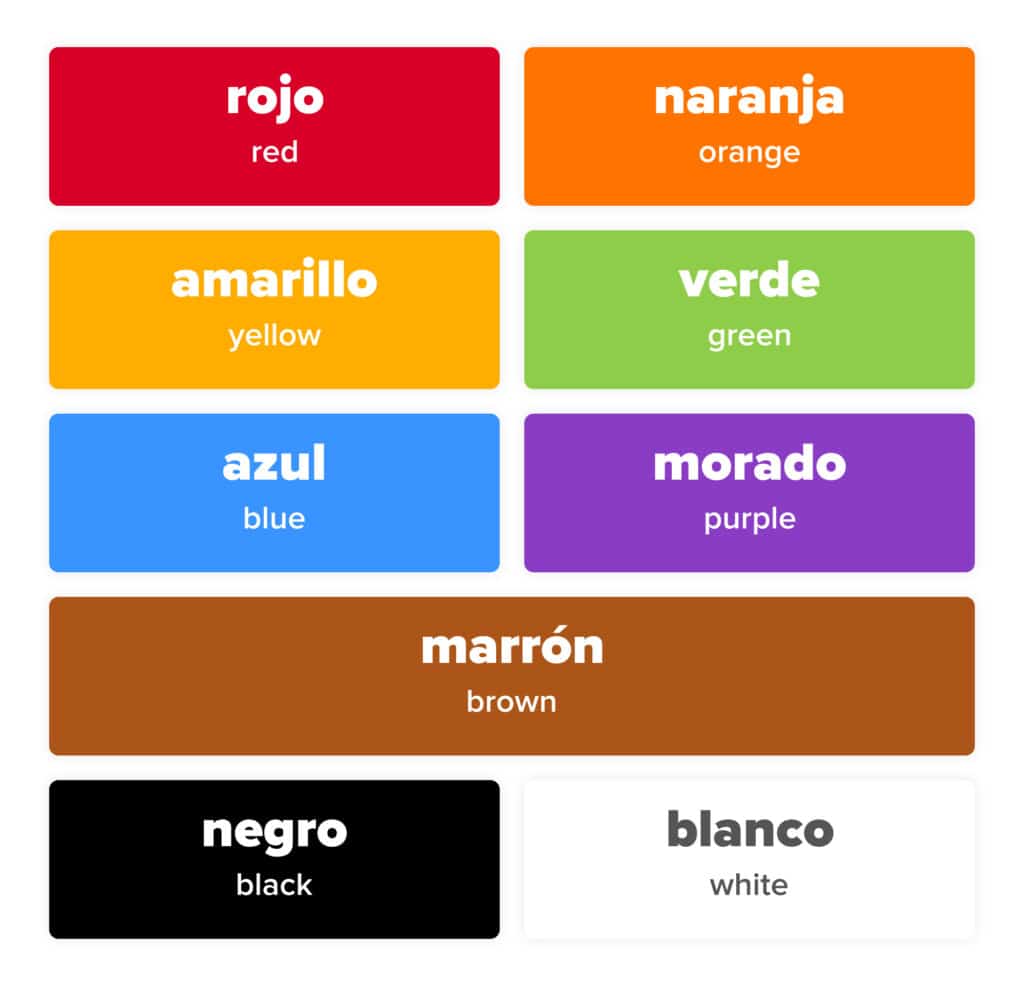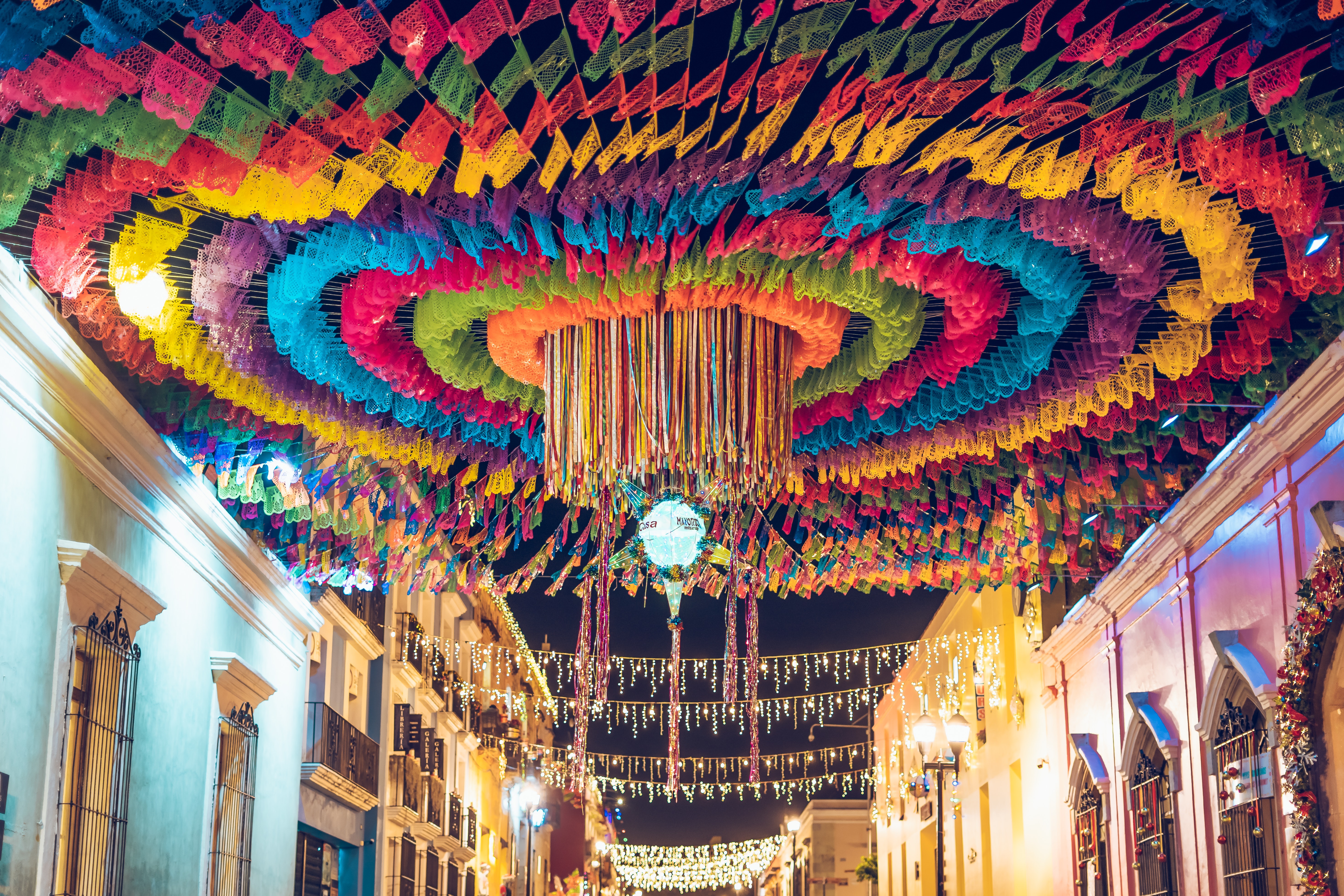
What were the first words you learned in Spanish?
I’d guess that some of them were colors!
It’s not hard to see why—color words are essential for lots of tasks, from writing creatively and understanding poetry, to indicating objects and expressing likes and dislikes.
This article will show you some of the most common Spanish color words, as well as the most important rules for using them!
Contents
Download:
This blog post is available as a convenient and portable PDF that you
can take anywhere.
Click here to get a copy. (Download)
Essential Spanish Colors

Rojo / Roja — Red
Anaranjado / Anaranjada / Naranja — Orange
Amarillo / Amarilla — Yellow
Verde — Green
Azul — Blue
Morado / Morada — Purple
Marrón / Café — Brown
Negro / Negra — Black
Blanco / Blanca — White
Rosado / Rosada / Rosa — Pink
Violeta — Violet, Purple
Lila — Lilac
Gris — Gray
Magenta — Magenta
Escarlata — Scarlet
Ámbar — Amber
Turquesa — Turquoise
Índigo — Indigo
Granate — Maroon
Dorado / Dorada — Gold
Plateado / Plateada — Silver
Note that some colors don’t change with gender—in our lists, these are the colors which only have a single translation. For example, azul and verde don’t change gender, whereas negro and morado do.
Also note that anaranjado/anaranjada (orange) and marrón (brown) are more common in Spain, whereas you’ll likely hear naranja (orange) and café (brown) used in Latin America.
Words To Describe Colors

Spanish Colors To Describe People

Eye Color
Skin Color
Hair Color
Grammar Rules for Using Colors in Spanish Sentences

You may already know some of these rules, so here’s a quick refresher. However, if you’re not super familiar with these, with some practice you’ll have them down pat.
You can speed up that process by exposing yourself to lots of native Spanish content, so you can hear how native speakers talk about colors. You can find native content on YouTube, or a language learning program like FluentU.
FluentU comes with over 1000 authentic Spanish videos—including things like news reports, music videos and vlogs—which all come with interactive subtitles.
It makes learning more efficient as it’s easier to spot instances of color words and rules. Plus, just click on the words and structures to see their definitions, pronunciations, example sentences and to automatically add it to a flashcard deck.
1. Pay attention to word order
Like most Spanish adjectives, the color words go after the noun they describe.
For example:
El coche azul. (The blue car. Literally, “the car blue.”)
2. Watch out for number and gender
When using the color words as adjectives, you must make the colors agree with the number and gender of the noun.
For example, el sofá (the sofa) is a singular, masculine noun. Las actrices (the actresses) is a plural, feminine noun.
As with all Spanish adjectives, you must ensure that the color words agree with the noun they describe.
Los ojos azules. (The blue eyes.)
Las casas blancas. (The white houses.)
3. A color that doesn’t end in o won’t change its spelling
Gender change rules don’t always apply, as any color that doesn’t end in an o won’t change its spelling.
For example: verde (green), azul (blue) and rosa (pink).
4. You usually use ser with colors
When describing what color something is, such as in a sentence like “The phone is black,” you almost always use the verb ser.
El teléfono es negro. (The phone is black.)
Las botellas son amarillas. (The bottles are yellow.)
The verb estar (to be) generally refers to temporary states of being. There are rare cases in which you might need to use estar to describe the color of something.
Here’s an example: If you wanted to say that today the sky is gray because of an impending rainstorm, you could use the verb estar (since it’s normally blue):
El cielo está gris. (The sky is gray.)
5. Use “de color” to simplify things
Another way to describe color in Spanish is to say that something is de color… (the color…).
With this construction, you’ll always use the masculine, singular version of the color—regardless of the noun!
Las camisetas son de color rosa. (The shirts are the color pink.)
6. Colors don’t change gender in the noun + color + adjective/noun formula
When you combine noun + color + adjective/noun, the color and adjective/noun don’t change genders.
This means that no matter what gender or number the main noun is, the color and the adjective/noun will remain in the masculine singular form.
For example:
El libro azul oscuro. (The dark blue book.)
La camisa azul oscuro. (The dark blue shirt.)
Los libros azul oscuro. (The dark blue books.)
Las camisas azul oscuro. (The dark blue shirts.)
7. Colors can be nouns
Colors can also act as nouns, not just adjectives.
When a color functions as a noun, it will always be masculine, no matter what.
El rosa es mi color favorito. (Pink is my favorite color.)
Los naranjas te quedan muy bien. (Orange colors suits you very well.)
Spanish Colors Practice Quiz

Now that you know the most important colors in Spanish, it’s time to practice them! By practicing the colors, you’ll be able to start using them in your own Spanish conversations to add extra information.
1. Me gustan tus zapatos (red). (I like your red shoes.)
2. No encuentro mi falda (black). (I can’t find my black skirt.)
3. El (yellow) es mi color favorito. (Yellow is my favorite color.)
4. Tengo los ojos (green). (I have green eyes.)
5. El (orange) es un color cálido. (Orange is a warm color.)
6. Mi abrigo es de color (pink). (My coat is pink.)
7. No puedo quitar una mancha de mi camisa (white). (I can’t remove a stain on my white shirt.)
8. Mi amiga tiene un coche (light blue). (My friend has a light blue car.)
9. Hay tantas casas (colorful) en México. ¡Son espectaculares! (There are so many colorful houses in Mexico. They are spectacular!)
10. Parece que va a llover pronto. El cielo está (gray). (It looks like it’s going to rain soon. The sky is gray.)
Answers:
1. Rojos
2. Negra
3. Amarillo
4. Verdes
5. Anaranjado/naranja
6. Rosado/Rosa
7. Blanca
8. Azul claro
9. Coloridas
10. Gris
The Spanish colors are simple to learn and use once you get the hang of a few rules.
And they improve your ability to express yourself in Spanish, whether it be in a supermarket or in a poetry workshop.
So, go forth and add color to your Spanish!
Download:
This blog post is available as a convenient and portable PDF that you
can take anywhere.
Click here to get a copy. (Download)



